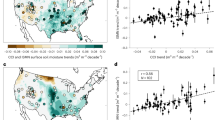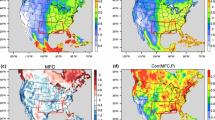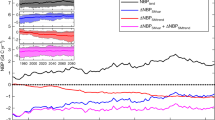Abstract
A coupled modeling framework including a terrestrial ecosystem model and an atmospheric radiative transfer model is used to evaluate the aerosols’ direct radiative effects on the surface soil moisture in global terrestrial ecosystems during 2003–2010. We conduct two sets of model runs with and without aerosols in a hindcast mode. Comparison analysis indicates that the simulated soil moisture is comparable with other existing products and satellite retrievals. Simulations with aerosol loadings show an increase in the surface soil moisture by 3.8 ± 0.4 % and 4.1 ± 0.5 % during growing seasons (June to September) in temperate and boreal Northern Hemisphere (>10 °N) and the whole year in tropical regions (−10°S~10°N). This positive effect is as large as 30 % in dense-vegetated ecosystems, such as tropical forests and temperate broadleaf evergreen forests. The effect of aerosols on soil moisture varies with local leaf area index and climate, and exhibits seasonal variations. Surface soil moisture is persistently affected by high aerosols loadings in Amazonian tropical forests during drought seasons of 2005 and 2010. This study highlights the importance to consider the aerosols’ effects in impacting the soil moisture dynamics of the global terrestrial ecosystems.





Similar content being viewed by others
References
Albergel C, De Rosnay P, Balsamo G et al (2012) Soil moisture analyses at ECMWF: evaluation using global ground-based in situ observations. J Hydrometeorol 13:1442–1460
Al-Yaari A, Wigneron J-P, Ducharne A et al (2014) Global-scale evaluation of two satellite-based passive microwave soil moisture datasets (SMOS and AMSR-E) with respect to land data assimilation system estimates. Remote Sens Environ 149:181–195
Auffhammer M, Ramanathan V, Vincent JR (2006) Integrated model shows that atmospheric brown clouds and greenhouse gases have reduced rice harvests in India. Proc Natl Acad Sci 103:19668–19672. doi:10.1073/pnas.0609584104
Balsamo G, Albergel C, Beljaars A et al (2013) ERA-Interim/Land: a global land water resources dataset. Hydrol Earth Syst Sci Discuss 10:14705–14745
Barichivich J, Briffa KR, Myneni R et al (2014) Temperature and snow-mediated moisture controls of summer photosynthetic activity in northern terrestrial ecosystems between 1982 and 2011. Remote Sens 6:1390–1431
Bevan SL, North PRJ, Grey WMF et al (2009) Impact of atmospheric aerosol from biomass burning on Amazon dry-season drought. J Geophys Res 114:D09204. doi:10.1029/2008JD011112
Biggs TW, Scott CA, Gaur A et al (2008) Impacts of irrigation and anthropogenic aerosols on the water balance, heat fluxes, and surface temperature in a river basin. Water Resour Res 44:W12415. doi:10.1029/2008WR006847
Boer GJ, Flato G, Ramsden D (2000) A transient climate change simulation with greenhouse gas and aerosol forcing: projected climate to the twenty-first century. Clim Dyn 16:427–450
Carslaw KS, Boucher O, Spracklen DV et al (2010) A review of natural aerosol interactions and feedbacks within the earth system. Atmos Chem Phys 10:1701–1737
Chen M (2013) Evaluation of atmospheric aerosol and tropospheric ozone effects on global terrestrial ecosystem carbon dynamics. Proquest Digital Dissertations, Doctor of Philosophy Dep., Purdue Univ., West Lafayette, Ind
Chen M, Zhuang Q (2014) Evaluating aerosol direct radiative effects on global terrestrial ecosystem carbon dynamics from 2003 to 2010. Tellus B 66:21808
Chen M, Zhuang Q, He Y (2014) An efficient method of estimating downward solar radiation based on the MODIS observations for the use of land surface modeling. Remote Sens 6:7136–7157
Cook BI, Bonan GB, Levis S (2006) Soil moisture feedbacks to precipitation in southern Africa. J Clim 19:4198–4206
Costantino L, Bréon F (2010) Analysis of aerosol-cloud interaction from multi-sensor satellite observations. Geophys Res Lett 37:L11801. doi:10.1029/2009GL041828
Dai A (2011) Drought under global warming: a review. Wiley Interdiscip Rev Clim Chang 2:45–65. doi:10.1002/wcc.81
Dai Y, Dickinson RE, Wang Y-P (2004) A two-big-leaf model for canopy temperature, photosynthesis, and stomatal conductance. J Clim 17:2281–2299
Desboeufs KV, Sofikitis A, Losno R et al (2005) Dissolution and solubility of trace metals from natural and anthropogenic aerosol particulate matter. Chemosphere 58:195–203. doi:10.1016/j.chemosphere.2004.02.025
Diffenbaugh NS, Pal JS, Giorgi F, Gao X (2007) Heat stress intensification in the Mediterranean climate change hotspot. Geophys Res Lett 34:L11706. doi:10.1029/2007GL030000
Dorigo WA, Gruber A, De Jeu RAM et al (2015) Evaluation of the ESA CCI soil moisture product using ground-based observations. Remote Sens Environ 162:380–395
Durre I, Wallace JM, Lettenmaier DP (2000) Dependence of extreme daily maximum temperatures on antecedent soil moisture in the contiguous United States during summer. J Clim 13:2641–2651
Ek MB, Holtslag AAM (2004) Influence of soil moisture on boundary layer cloud development. J Hydrometeorol 5:86–99
Farquhar GD, von Caemmerer S, Berry JA (1980) A biochemical model of photosynthetic CO2 assimilation in leaves of C3 species. Planta 149:78–90
Findell KL, Eltahir EAB (2003) Atmospheric controls on soil moisture-boundary layer interactions. Part II: Feedbacks within the continental United States. J Hydrometeorol 4:570–583
Gueymard CA (2012) Clear-sky irradiance predictions for solar resource mapping and large-scale applications: Improved validation methodology and detailed performance analysis of 18 broadband radiative models. Sol Energy 86:2145–2169
Hohenegger C, Brockhaus P, Bretherton CS, Schär C (2009) The soil moisture-precipitation feedback in simulations with explicit and parameterized convection. J Clim 22:5003–5020
Holben BN, Tanré D, Smirnov A et al (2001) An emerging ground-based aerosol climatology: aerosol optical depth from AERONET. J Geophys Res Atmos 106:12067–12097. doi:10.1029/2001JD900014
Huang Y, Chameides WL, Dickinson RE (2007) Direct and indirect effects of anthropogenic aerosols on regional precipitation over east Asia. J Geophys Res 112:D03212. doi:10.1029/2006JD007114
Jaeger EB, Seneviratne SI (2011) Impact of soil moisture–atmosphere coupling on European climate extremes and trends in a regional climate model. Clim Dyn 36:1919–1939
Jaeger EB, Stöckli R, Seneviratne SI (2009) Analysis of planetary boundary layer fluxes and land-atmosphere coupling in the regional climate model CLM. J Geophys Res 114:D17106. doi:10.1029/2008JD011658
Kalnay E, Kanamitsu M, Kistler R et al (1996) The NCEP/NCAR 40-year reanalysis project. Bull Am Meteorol Soc 77:437–471
King MD, Menzel WP, Kaufman YJ et al (2003) Cloud and aerosol properties, precipitable water, and profiles of temperature and water vapor from MODIS. Geosci Remote Sens IEEE Trans 41:442–458
Koster RD, Dirmeyer PA, Guo Z et al (2004) Regions of strong coupling between soil moisture and precipitation. Science (80-) 305:1138–1140
Levy RC, Remer LA, Martins JV et al (2005) Evaluation of the MODIS aerosol retrievals over ocean and land during CLAMS. J Atmos Sci 62:974–992
Levy RC, Remer LA, Kleidman RG et al (2010) Global evaluation of the Collection 5 MODIS dark-target aerosol products over land. Atmos Chem Phys 10:10399–10420
Lewis SL, Brando PM, Phillips OL et al (2011) The 2010 amazon drought. Science (80-) 331
Liepert BG (2004) Can aerosols spin down the water cycle in a warmer and moister world? Geophys Res Lett. doi:10.1029/2003gl019060
Liu S, Chen M, Zhuang Q (2014) Aerosol effects on global land surface energy fluxes during 2003–2010. Geophys Res Lett 41:7875–7881
Loew A, Stacke T, Dorigo W et al (2013) Potential and limitations of multidecadal satellite soil moisture observations for selected climate model evaluation studies. Hydrol Earth Syst Sci 17:3523–3542
Magnani F, Mencuccini M, Borghetti M et al (2007) The human footprint in the carbon cycle of temperate and boreal forests. Nature 447:849–851
Mahowald N (2011) Aerosol indirect effect on biogeochemical cycles and climate. Science (80-) 334:794–796
Mahowald NM, Baker AR, Bergametti G et al (2005) Atmospheric global dust cycle and iron inputs to the ocean. Glob Biogeochem Cycles 19:GB4025. doi:10.1029/2004GB002402
Marengo JA, Nobre CA, Tomasella J et al (2008) The drought of Amazonia in 2005. J Clim 21:495–516
Marengo JA, Tomasella J, Alves LM et al (2011) The drought of 2010 in the context of historical droughts in the Amazon region. Geophys Res Lett 38:L12703. doi:10.1029/2011GL047436
Matsui T, Beltrán‐Przekurat A, Niyogi D et al (2008) Aerosol light scattering effect on terrestrial plant productivity and energy fluxes over the eastern United States. J Geophys Res 113:D14S14. doi:10.1029/2007JD009658
Muñoz AA, Barichivich J, Christie DA et al (2014) Patterns and drivers of Araucaria araucana forest growth along a biophysical gradient in the northern Patagonian Andes: linking tree rings with satellite observations of soil moisture. Aust Ecol 39:158–169
Murthy BS, Latha R, Kumar M, Mahanti NC (2014) Effect of aerosols on evapo-transpiration. Atmos Environ 89:109–118
Niyogi D, Chang H, Saxena VK et al (2004) Direct observations of the effects of aerosol loading on net ecosystem CO2 exchanges over different landscapes. Geophys Res Lett 31:L20506. doi:10.1029/2004GL020915
Ohmura A, Gilgen H, Hegner H et al (1998) Baseline surface radiation network (BSRN/WCRP): new precision radiometry for climate research. Bull Am Meteorol Soc 79:2115–2136
Péré JC, Mallet M, Pont V, Bessagnet B (2011) Impact of aerosol direct radiative forcing on the radiative budget, surface heat fluxes, and atmospheric dynamics during the heat wave of summer 2003 over western Europe: a modeling study. J Geophys Res 116:D23119. doi:10.1029/2011JD016240
Platnick S, King MD, Ackerman SA et al (2003) The MODIS cloud products: algorithms and examples from Terra. Geosci Remote Sens IEEE Trans 41:459–473
Ramanathan V, Crutzen PJ, Kiehl JT, Rosenfeld D (2001) Aerosols, climate, and the hydrological cycle. Science (80-) 294:2119–2124. doi:10.1126/science.1064034
Remer LA, Kaufman YJ, Tanré D et al (2005) The MODIS aerosol algorithm, products, and validation. J Atmos Sci 62:947–973
Robock A, Vinnikov KY, Srinivasan G et al (2000) The global soil moisture data bank. Bull Am Meteorol Soc 81:1281–1299
Roderick ML, Farquhar GD (2002) The cause of decreased pan evaporation over the past 50 years. Science (80-) 298:1410–1411
Rosenfeld D, Lohmann U, Raga GB et al (2008) Flood or drought: how do aerosols affect precipitation? Science (80-) 321:1309–1313
Schaaf CB, Gao F, Strahler AH et al (2002) First operational BRDF, albedo nadir reflectance products from MODIS. Remote Sens Environ 83:135–148. doi:10.1016/S0034-4257(02)00091-3
Schrier G, Barichivich J, Briffa KR, Jones PD (2013) A scPDSI-based global data set of dry and wet spells for 1901–2009. J Geophys Res Atmos 118:4025–4048
Seneviratne SI, Stöckli R (2008) The role of land–atmosphere interactions for climate variability in Europe. Clim Var Extrem Dur Past 100:179–193
Seneviratne SI, Corti T, Davin EL et al (2010) Investigating soil moisture–climate interactions in a changing climate: a review. Earth Sci Rev 99:125–161. doi:10.1016/j.earscirev.2010.02.004
Sheffield J, Goteti G, Wood EF (2006) Development of a 50-year high-resolution global dataset of meteorological forcings for land surface modeling. J Clim 19:3088–3111. doi:10.1175/JCLI3790.1
Steiner AL, Mermelstein D, Cheng SJ et al (2013) Observed impact of atmospheric aerosols on the surface energy budget. Earth Interact 17:1–22
Stephens GL, Ackerman S, Smith EA (1984) A shortwave parameterization revised to improve cloud absorption. J Atmos Sci 41:687–690
Szczypta C, Calvet J-C, Maignan F et al (2014) Suitability of modelled and remotely sensed essential climate variables for monitoring Euro-Mediterranean droughts. Geosci Model Dev 7:931–946
Taylor CM, Ellis RJ (2006) Satellite detection of soil moisture impacts on convection at the mesoscale. Geophys Res Lett 33:L03404. doi:10.1029/2005GL025252
Taylor CM, de Jeu RAM, Guichard F et al (2012) Afternoon rain more likely over drier soils. Nature 489:423–426
Trenberth KE, Fasullo JT, Kiehl J (2009) Earth’s global energy budget. Bull Am Meteorol Soc 90:311–323. doi:10.1175/2008BAMS2634.1
Twomey S (1977) The influence of pollution on the shortwave albedo of clouds. J Atmos Sci 34:1149–1152
van der Werf GR, Randerson JT, Giglio L et al (2010) Global fire emissions and the contribution of deforestation, savanna, forest, agricultural, and peat fires (1997–2009). Atmos Chem Phys 10:11707–11735. doi:10.5194/acp-10-11707-2010
Wang K, Dickinson RE, Liang S (2008) Observational evidence on the effects of clouds and aerosols on net ecosystem exchange and evapotranspiration. Geophys Res Lett 35:L10401. doi:10.1029/2008GL034167
Western AW, Zhou S-L, Grayson RB et al (2004) Spatial correlation of soil moisture in small catchments and its relationship to dominant spatial hydrological processes. J Hydrol 286:113–134
Yu H, Kaufman YJ, Chin M et al (2006) A review of measurement-based assessments of the aerosol direct radiative effect and forcing. Atmos Chem Phys 6:613–666. doi:10.5194/acp-6-613-2006
Zeng N, Yoon J-H, Marengo JA et al (2008) Causes and impacts of the 2005 Amazon drought. Environ Res Lett 3:14002
Zhang J, Wang W, Wu L (2009) Land-atmosphere coupling and diurnal temperature range over the contiguous United States. Geophys Res Lett 36:L06706. doi:10.1029/2009GL037505
Acknowledgements
We acknowledge that the model forcing data for this study are provided by Land Surface Hydrology Research Group at Princeton University. This research is funded to Q.Z. by the NASA Land Use and Land Cover Change program (NASA-NNX09A126G), the Department of Energy (DE-FG02-08ER64599), the National Science Foundation (NSF-102891 and NSF-0919331), NSF Carbon and Water in the Earth Program (NSF-0630319) and the NSF CDI Type II project (IIS-1028291)
Author information
Authors and Affiliations
Corresponding author
Additional information
Shaoqing Liu and Min Chen contributed equally to this work.
Rights and permissions
About this article
Cite this article
Liu, S., Chen, M. & Zhuang, Q. Direct radiative effects of tropospheric aerosols on changes of global surface soil moisture. Climatic Change 136, 175–187 (2016). https://doi.org/10.1007/s10584-016-1611-7
Received:
Accepted:
Published:
Issue Date:
DOI: https://doi.org/10.1007/s10584-016-1611-7




